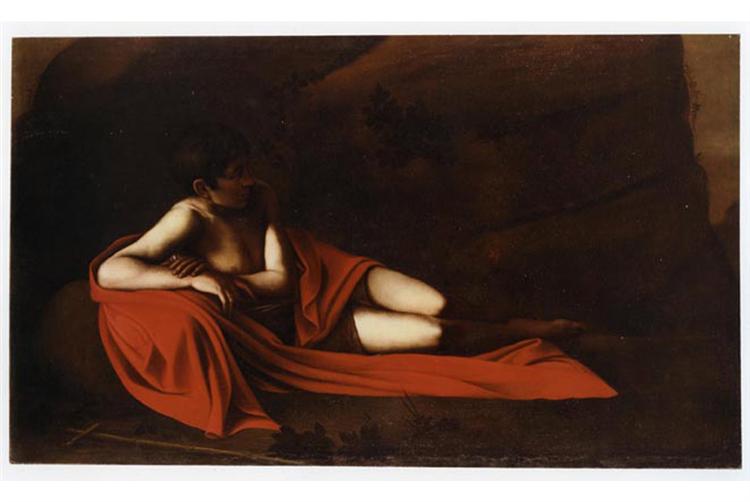תיאור
הציור "חואן אל באוטיסטה (הבפטיסט השוכן)", שנעשה בשנת 1610 על ידי קרוואג'יו, הוא יצירה מרתקת המכה את שליטתו של האמן בשימוש בקיארוסקורו ויכולתו לייצג את הדמות האנושית באינטימיות מדהימה. ציור זה, המציג את סן חואן באוטיסטה במצב מנוחה, מציע פרשנות חדשה של הקדוש, המופשט מההילה של הקדושה המסורתית וקרוב יותר לאנושות גולמית ורגשית.
בציור, חואן מציג שכיבה, כשראשו נח על הזרוע, מה שמרמז על גישה מהורהרת ומלנכולית. הבחירה בתנוחה זו, כל כך טבעית ואמיתית, היא עדות לסגנון החדשני של קרוואג'יו, שקרא תיגר על המוסכמות של זמנו על ידי הצגת הקדושים לא רק כדמויות אלוהיות, אלא כנשמות שחוות ייסורים וחוסר שקט. נראה כי הבעתו של חואן, במבטו האבוד ובביטויו המהורהר, מזמינה אותנו להרהר בחייו ובמשימתו הנבואית.
היצירה מורכבת כך שדמותו של חואן תופסת את המרכז, שולטת על הבד ומייצרת קשר רגשי חזק עם הצופה. השימוש ב- Chiaroscuro הוא אדיר: האורות מאירים את פניהם וחלק מהדמות שלהם, מדגישים את קווי המתאר ואת פרטי עורם, בעוד שהרקע הכהה משפר את הדמות ויוצר אווירת מסתורין העוטפת את הצבע. טכניקה זו, מאפייני קרוואג'יו, לא רק משמשת לתת נפח לצורות, אלא גם קובעת דיאלוג עימות בין אור לצל, ומזמינה את הצופה לטבול את עצמם בעולם הפסיכולוגי של היצירה.
הצבע בסרט "חואן אל באוטיסטה" עדין, נשלט על ידי לוח האדמה הכולל גווני חום, בז 'וזהב, עם נגיעות אדומות וירוק המציעות עומק ושונות. בחירה כרומטית זו מחזקת את האותנטיות החזקה של הדיוקן, מתרחקת מהשימוש המופרז בצבעים תוססים שלעתים קרובות ניתן למצוא ביצירות עכשוויות אחרות. עורו של הקדוש מראה נטורליזם כה עמוק עד שנראה שהוא פועם בחיים, טכניקה שקרוואג'יו שיכללה לאורך הקריירה שלו וניתן למצוא ביצירות אחרות כמו "ייעוד סן מטאו" או "ארוחת ערב באמוס".
חשוב לציין כי דיוקנו של ג'ון המטביל אינו מלווה בדמויות אחרות, מה שמעצים את תחושת הבדידות וההשתקפות. הבחירה לחסל הסחות דעת ולהתמקד בדמותו של חואן היא החלטה המשפרת את תחושת האינטימיות והקשר הרגשי עם הצופה. קרוואג'יו, הידוע גם בבחינת סוגיות האור והצל, מיישם אותו כאן על מנת לעורר אווירה של התבוננות פנימית, מאפיינים הממצאים את מורשתם כמנהיג הטנבריזם.
היצירה נצבעו ברגע מכריע בחייו של קרוואג'יו, רגע לפני מותו, שניתן היה לפרש אותו כהשקפה עצמית של המסע הסוער שלו. זה מוסיף נדבך עומק ליצירה, מכיוון שיצירותיו האחרונות של האמן מכילות לעיתים קרובות נטל רגשי ייחודי ופגיעות מוחשית.
"ג'ון המטביל (שוכב הבפטיסט)" עומד לא רק כעדות לשליטה הטכנית של קרוואג'יו, אלא גם כהשתקפות של המורכבות הרגשית של האדם. הבחירה לייצג את הקדוש בתקופה של הפסקה מזמינה את הצופים להרהר לא רק בתפקידם בקריינות המקראית, אלא גם זו של כל אחד מאיתנו בחיינו שלנו. היצירה נותרה השראה ואבן דרך בהיסטוריה של האמנות, דוגמה ברורה ליכולתו של קרוואג'יו למזג את האלוהי עם חיי היומיום, ומורשתו נמשכת באינספור הפרשנויות שנוצרו מאז על אמנות ורוחניות.
KUADROS ©, צבע מפורסם על הקיר שלך.
ציורי שמן בעבודת יד, עם איכות אמנים מקצועיים וחותם ייחודי של KUADROS ©.
שירות רבייה בתמונות עם ערבות שביעות רצון. אם אינך מרוצה לחלוטין מהעתק הציור שלך, אנו מחזירים את הכסף שלך 100%.

